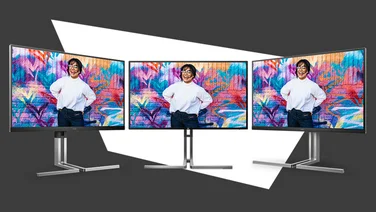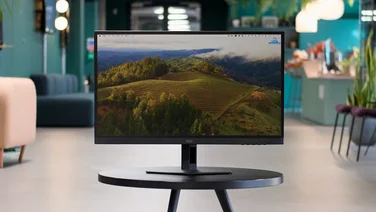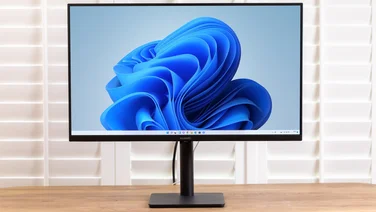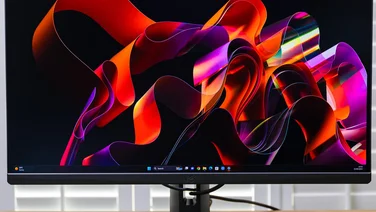To help us provide you with free impartial advice, we may earn a commission if you buy through links on our site. Learn more




We’ve reviewed our fair share of Ultra HD (4K) TVs, but the Dell UP2414Q is the first monitor we’ve seen with a 3,840×2,160 resolution. Many Ultra HD displays are over 32in, but the UP2414Q uses a 23.8in IPS panel, giving it a huge pixel density of 185 pixels-per-inch (PPI). The level of detail it brings to the screen is absolutely stunning, but there are issues.

Everything certainly looked razor sharp in Windows 8, and the extra resolution is great for editing photos and videos, but you’ll need to make a few changes before the Windows desktop is usable. First, you’ll need to change the size in the Control Panel’s Display settings. At 100 per cent, text and icons are rendered miniature, making them so tiny that you’re likely to strain your eyes when trying to read anything. Increasing this setting to the usual maximum of 150 makes it usable for those who don’t mind things being on the small side.
However, you’ll still suffer from issues in many applications, with so many pixels packed into such a small space buttons and toolbars can become tiny. Some applications support such high resolutions (often called HiDPI) but many still don’t and are rendered almost unusable as a result.
You’ll also need to use the monitor’s DisplayPort input if you want to make use of the UP2414Q’s maximum 60Hz refresh rate, as it can only refresh at 30Hz when video is input via HDMI. Thankfully, the UP2414Q has two DisplayPort inputs: one mini and one full size. At 30Hz the Windows Start screen animations became jerky and even simple tasks such as dragging windows across the desktop caused judder.
We’d recommend saving the HDMI input for a secondary device such as a Blu-ray player, though 1,920×1,080-resolution images looked unusually grainy and pixelated.

At 60Hz Windows was great. We reviewed the Dell UP2414Q with an AMD R9 280X and an Nvidia GeForce GTX 760 graphics card. Both were able to support the resolution at 60Hz instantly, but only once we’d enabled the DisplayPort 1.2 setting in the monitor’s onboard display menu. Strangely, this setting is disabled by default, however the menu is easy to navigate and the responsive touch-control buttons are simple to use.
Apple fans will be disappointed, as we had little success in connecting the UP2414Q to Apple’s 2014 Mac Pro. When we connected the Mac Pro to the UP2414Q, OS X didn’t recognise the display and only produced a mess of colours at a resolution of 1,920×2,160, which is one half of 3,840×2,160. We contacted Dell to ask why this might be, but we didn’t get a response by the time we went to print.
We had better luck with a 2013 Macbook Pro with Retina Display, but this wasn’t perfect either. We could get a full 3,840×2,160 resolution on the UP2414Q when we extended the desktop, but OS X doesn’t offer additional scaling options to make the resolution more user-friendly, and the refresh rate was limited to 30Hz.

If you have the hardware to drive the monitor, then the UP2414Q has everything else we’d expect from a top-of-the-range monitor. Its sturdy, height-adjustable stand can reach a maximum height of 180mm and it can pivot 90 degrees so you can view your desktop in portrait mode. The UP2414Q also has a four-port USB3 hub and a multiformat card reader.
The UP2414Q’s image quality didn’t disappoint either. At its default settings, our colour calibrator showed it was already displaying 99.9 per cent of the sRGB colour gamut. This is outstanding even for an IPS panel and its even coverage across all the main colour groups meant there was very little need to calibrate it.
Unsurprisingly, all of our solid colour tests looked fantastic, with reds, greens and blues virtually popping out of the screen. Whites were also incredibly clean and bright, and our low black level reading of 0.22cd/m2 translated into very deep blacks that were uniformly lit across the screen. The monitor’s contrast levels were also excellent. With a measured contrast ratio of 997:1, all of our high contrast test photos were packed with detail in both the light and dark areas of each image. Our night shots were particularly impressive, as even the darkest areas of shadow showed a good level of detail.

Should you need to adjust the monitor’s picture quality, there are plenty picture modes to choose from, including Standard, Multimedia, Movie, Game, Paper, Colour Temperature, Colour Space and Custom Colour. There are also options to adjust the brightness and contrast, and change the colour format, gamma settings, aspect ratio and sharpness levels.
The UP2414Q also supports Picture-by-Picture via DisplayPort, mini DisplayPort or HDMI to show two displays side by side on the same monitor. You’ll want to adjust the size setting to Aspect Ratio, though, as setting it to Full squashes each display to completely fill its respective half of the screen – though that may prove useful if you’re quickly doing a spot of multitasking between two devices.
The Dell UP2414Q is certainly an impressive monitor, and it’s well priced compared to Ultra HD displays such as the £2,800 Asus PQ321QE and £3,500 Sharp PN-K321. It’s a shame the UP2414Q isn’t compatible with Apple products, but if you have the correct hardware to drive it, the UP2414Q is incredibly impressive.
It’s early days for Ultra HD though and there are still big issues, there’s simply not good enough support yet for such high PPI monitors, either in the OS or applications. If you’re really keen on getting an Ultra HD monitor then you’ll want to invest a huge £2,769 in the 32in Dell UP3214Q. Its bigger screen, by around 56%, largely offsets the scaling issues seen here.






